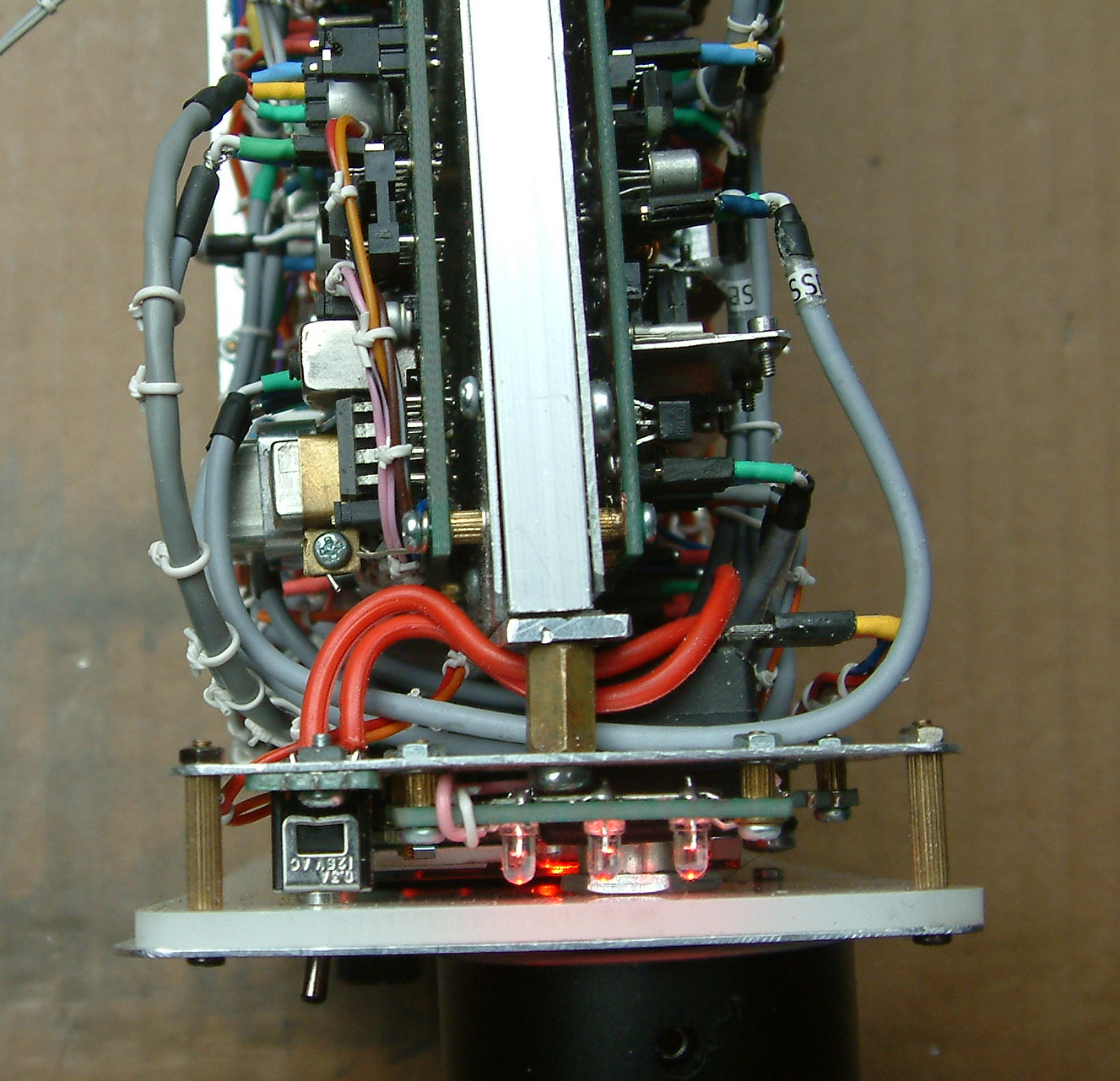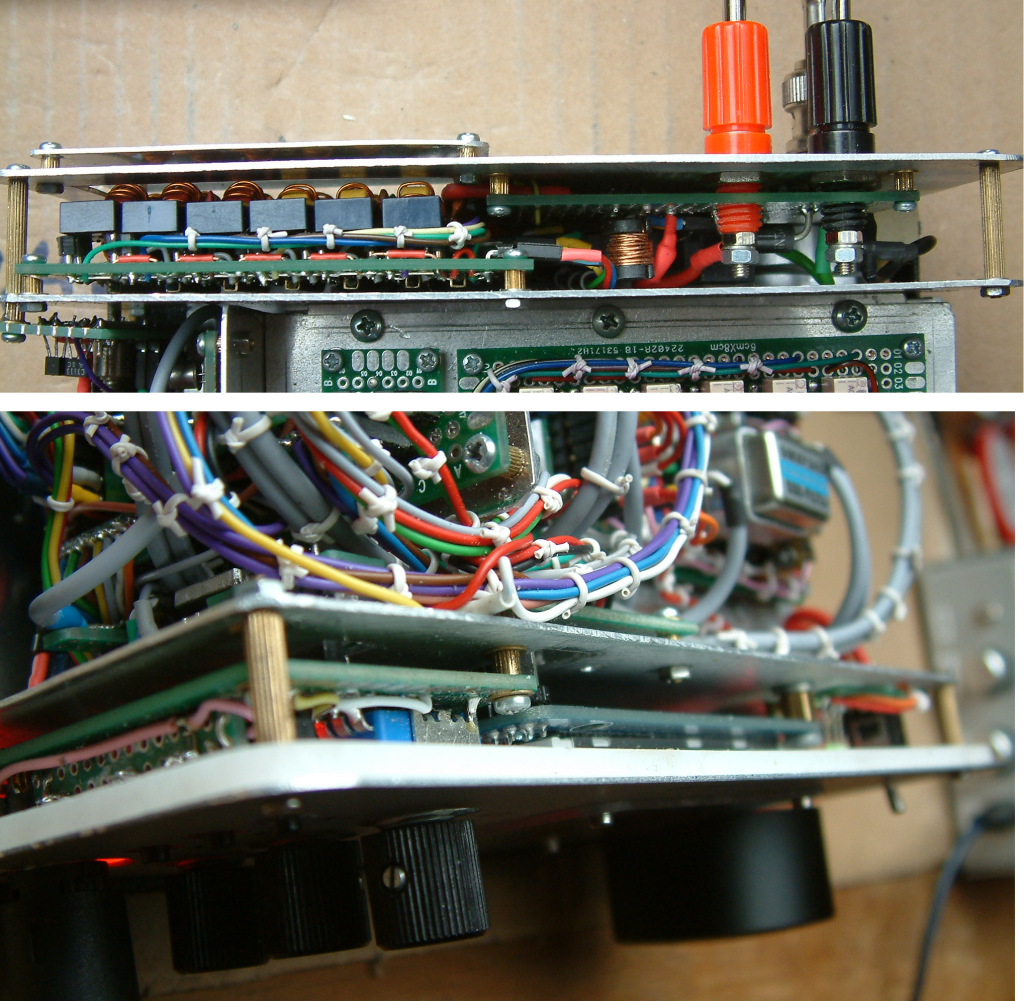My transceivers usually don’t use any ready-made cabinets. To save space and have full and easy access to all parts of the radio during construction, adjusting, assessment and repair I prefer an open 2-layer sandwich method.
There usually is one centered frame that is fixed using M3 or M4 bolts to the front panel carrier and the rear wall or carrier (if the rear wall consists of a more complex structure):

The center carrier here consists of 4 aluminum bars that have quadratic cross section (7mm edge length) and are building up a rectangle. This a rugged basis for 2 aluminum sheets (0.8mm thickness). These aluminum sheets are fixed with bolts (M2 winding) fitting into screw threads inside the bars that have been cut in there before.
The single veroboards are bolted with spacers using M2 screw threads onto the aluminum sheets. These spacers are available from Chinese vendors on the internet and have a fairly low price. They have become my favorite mechanical aids when building compact radios. For higher demands concerning force I use the same devices in M3 or even M4.
The front and rear carriers are bolted into this center frame and support the front and rear panel:

At the top of the picture you can see the final LPF and the DC input for the transceiver mounted to the rear of the radio.
The front panel is made of an aluminum sheet metal (again 0.8mm thick) that has cutouts for the LCD, the controls, the push-buttons and the microphone jack.
The front panel light diffuser is made of a part of white translucent plastic bought from a shop that distributes material for architects. 3 strips of LEDs are mounted there also using the M2 spacers (3mm length).
The whole body then is placed into an outer cabinet that is composed of 2 halves of aluminum that have been bent into the correct form to fit the shape of front and rear panel.
The lower one has a height of only 1.5 centimeters. To connect the upper half on each side a strip of aluminum (2mm thickness) is bolted to the aluminum sheet close to the edge that carries screw threads to fix the upper and the lower half together to close the cabinet. These “sidebars” also affect the stability of the relatively thin cabinet in a positive way.

To avoid the interior section slipping out of the closed cabinet the two “sidebars” are cut into an appropriate length so that they “block” the inside from slipping out either to the front or the rear side.
Using aluminum has two major advantages in my point of view: First it is easy to be processed (in contrast for example when using metal sheets made of steel) and it is very lightweight what I prefer because I use my radios on frequent travel activities.
Vy 73 de Peter
WOW. I see three main boards, two in the sandwich and one on the side, plus the front and back boards. And then all of the interconnect wiring so neatly bundled and tied into harnesses. What are the cable ties made of? I imagine that in the process of building and testing everything must have been interconnected with longer wires and laid out on the workbench, with the final assembly into the cabinet frame and shorter wiring harnesses only done after everything was working. It looks like all wire connections to the harnesses are done with pin connectors so no soldering to the boards would be required, only on the ends of the harness bundles. You are only able to do it this way because most of the circuitry has been re-used from previous projects and is known to work. Still, lots of planning must be required even before starting to build each board module. Amazing work!
Hi WA2MZE,
well, building the rig was big fun even when we consider the big effort to get to the current state. 🙂
And, you are absolutely right, most of the circuitry has been tested before and proved to work adequately. The receiver board was taken from another project that I did not finish (a 40 meter hand held), the first DSB modulator and the TX-mixer baord also has been “disintegrated” from that project.
But the rig has been assembled in the mainframe used later so there was no big fuss with longer cables. The non-shielded interconnections are made from modelrailway cable (about 1.1mm outer diameter):
https://www.newmodellersshop.co.uk/electronics%20-%20wire.htm
The shielded ones are made from cable that is sold here from my local electronic store as “control line” to drive low-power remote devices and that has a very dense shielding.
And for sure the connections to boards are not soldered but by using the standard 0.1″ header strips. That makes it easy to change one whole board to another one with a modified circuit.
The whole planning, building and testing took about 6 months. Including wiriing >3000 lines of C code.
So, thanks for the compliments, very well appreciated! 🙂
Vy 73 de Peter(DK7IH)
Wonderful build quality and attention to detail. FB, OM! de N0ZGO
Thank You! 😉 Vy 73 de DK7IH
Hi O.M.Peter super design there are not much radio hams doing this with more than normal interest read your story
thanks a lot wish you all the best 73
Albert (PA3AQE)
Hi Albert, thank you very much! 🙂 I’ll always try my very best! 73 de Peter.